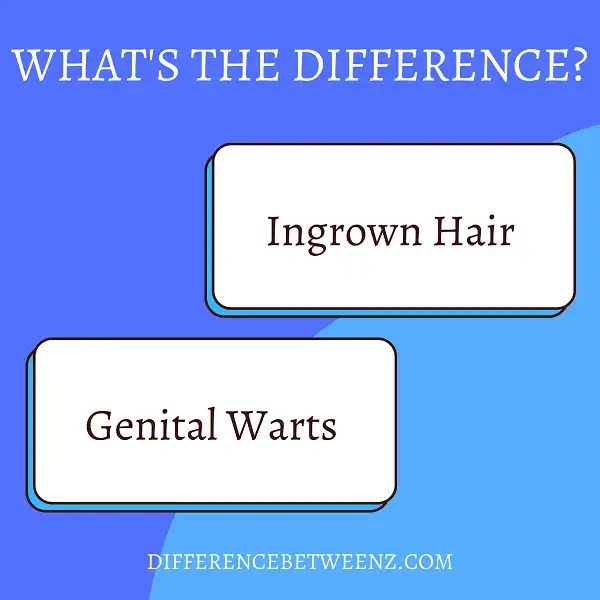Genital warts and ingrown hairs are both common issues that can occur in the genital area. While they may look similar, there are some key differences between these two conditions. In this blog post, we will take a closer look at the differences between ingrown hair and genital warts, including their symptoms, causes, and treatment options. By understanding the difference between these two conditions, you can better identify which one is affecting you and seek appropriate treatment.
What is Ingrown Hair?
Ingrown hair is a condition where the hair curls back or grows sideways into the skin. Ingrown hair can occur on any part of the body that grows hair, but is most common in areas where the skin is shaved, waxed, or plucked, such as the face, legs, armpits, and pubic area. Ingrown hair is often accompanied by redness, swelling, and itchiness. In severe cases, Ingrown hair can lead to infection and even scarring. There are several ways to prevent Ingrown hair, including exfoliating regularly and using a clean razor when shaving. If Ingrown hair does occur, it can usually be treated at home with over-the-counter lotions or creams. In rare cases, Ingrown hair may require medical intervention.
What are Genital Warts?
Genital warts are small, soft bumps that can grow on the genitals and surrounding area. They’re caused by the human papillomavirus (HPV), which is a sexually transmitted infection (STI). Genital warts are usually flesh-colored or whitish. They can be raised or flat. Some people have only a few warts, while others have many.
- Genital warts can appear on the vulva, inside the vagina, on the cervix, and around the anus in women. In men, they can appear on the penis and around the anus. Genital warts can be uncomfortable, but they’re usually not painful. In some cases, they can cause bleeding during sex. Genital warts are contagious and can be passed on through skin-to-skin contact, including sexual contact.
- You can also get them from contact with contaminated surfaces, such as towels, toilet seats, or other objects. The best way to prevent genital warts is to practice safe sex by using condoms and dental dams. If you think you have genital warts, see your doctor for a diagnosis and treatment. There is no cure for HPV, but there are treatments for genital warts.
- Left untreated, genital warts can go away on their own. However, they can also grow larger or spread to other parts of the body. In rare cases, HPV can cause cancer of the cervix in women or cancer of the penis in men.
- Genital warts are just one type of HPV infection. HPV is a common virus that’s very contagious and easily spread through sexual contact. Most people with HPV don’t have any symptoms and don’t know they have it. In most cases, the body clears HPV within one to two years and doesn’t cause any health problems.
However, some types of HPV can cause cancer of the cervix in women or cancer of the penis in men. Genital warts are just one type of HPV infection. There are more than 150 types of HPV, and most aren’t harmful. About 40 types can infect the genitals and lead to STIs like genital warts or cancer. Genital warts are most commonly caused by HPV types 6 and 11. These types don’t usually cause cancer but can still be passed on through sexual contact.”
Difference between Ingrown Hair and Genital Warts
Ingrown hair and genital warts are both growths that can occur on the skin. However, they are caused by different things and have different symptoms.
- Ingrown hair is caused when a hair follicle becomes clogged with sebum, dead skin cells, or bacteria. This can cause the hair to grow sideways into the skin instead of up and out.
- Ingrown hair usually appears as a small bump on the skin. It may be red, swollen, and painful.
- Genital warts, on the other hand, are caused by human papillomavirus (HPV).
- HPV is a sexually transmitted infection that can cause warts to grow on the genitals and surrounding areas.
- Genital warts usually appear as small, fleshy bumps. They may be arranged in a cluster or appear alone. They may be pink, white, or flesh-colored.
Ingrown hair can often be treated at home with over-the-counter products. However, genital warts may require treatment by a healthcare provider.
Conclusion
Ingrown hairs and genital warts may look similar, but they are two different conditions. If you have ingrown hair, there are a few things you can do to help it heal. If you think you have genital warts, however, it is important to see a doctor for treatment.


